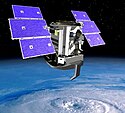CloudSat
 Wizja artystyczna satelity CloudSat | |
| Indeks COSPAR | 2006-016A |
|---|---|
| Indeks NORAD | 29107 |
| Państwo | |
| Zaangażowani | |
| Model satelity | BCP-2000[1] |
| Rakieta nośna | |
| Miejsce startu | |
| Orbita (docelowa, początkowa) | |
| Perygeum | 702 km[2] |
| Apogeum | 704 km[2] |
| Okres obiegu | 98,8 min[2] |
| Nachylenie | 98,2°[2] |
| Czas trwania | |
| Początek misji | 28 kwietnia 2006 10:02:16 UTC |
| Wymiary | |
| Masa całkowita | 848 kg[2] |

CloudSat – amerykański satelita do badań atmosfery, szczególnie chmur, który razem z innymi satelitami badawczymi (m.in. PARASOL, Aqua, Aura, CALIPSO) stanowi konstelację A-Train, pozwalającą na kolejne szybko następujące po sobie pomiary z orbity tego samego miejsca na Ziemi. A-Train ma na celu wielowymiarową obserwację procesów fizycznych zachodzących w chmurach i w atmosferze. CloudSat ma na pokładzie 3 mm radar meteorologiczny.
Wystrzelony 28 kwietnia 2006 razem z satelitą CALIPSO. Podstawowa misja satelity trwała 22 miesiące, jednak pracuje on do tej pory (wrzesień 2016). W czerwcu 2011 po problemach z zasilaniem jego orbita została obniżona i opuścił on konstelację A-Train. Powrócił do niej 15 maja 2012, po zakończeniu manewru podniesienia orbity[3].
Zobacz też
- Pomiary z programu GLOBE dla szkół będą wykorzystywane w analizie danych CloudSat.
Przypisy
Linki zewnętrzne
Media użyte na tej stronie
The flag of Navassa Island is simply the United States flag. It does not have a "local" flag or "unofficial" flag; it is an uninhabited island. The version with a profile view was based on Flags of the World and as a fictional design has no status warranting a place on any Wiki. It was made up by a random person with no connection to the island, it has never flown on the island, and it has never received any sort of recognition or validation by any authority. The person quoted on that page has no authority to bestow a flag, "unofficial" or otherwise, on the island.
CloudSat observing clouds
On Vandenberg Air Force Base Space Launch Complex 2W, the Delta II rocket stands ready for fueling in preparation for launch. The CALIPSO and CloudSat satellites are set to launch at 6:02 a.m. EDT on April 23 from Vandenberg Air Force Base (VAFB) on missions to study clouds and aerosols, tiny particles in the air. CALIPSO and CloudSat are set to fly into orbit aboard a Boeing Delta II rocket. The Delta II is designed to boost medium-sized satellites and robotic explorers into space. NASA selected a model 7420-10C for this mission, which is a two-stage rocket equipped with four strap-on motors and a protective 10-foot payload fairing.


